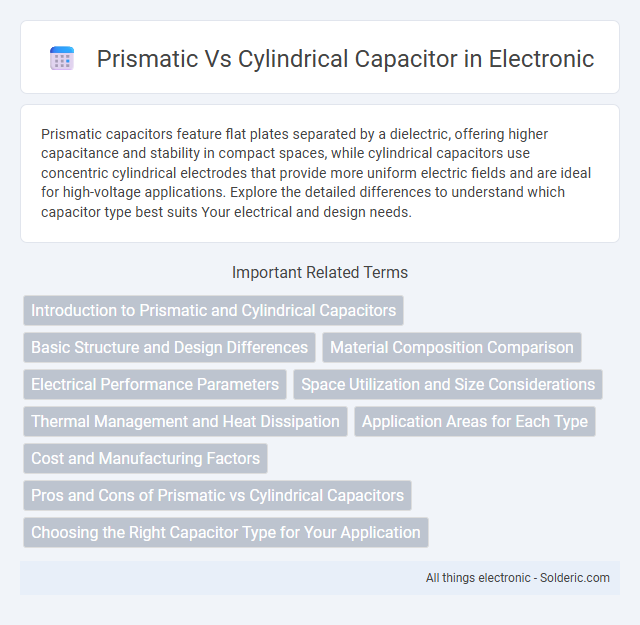Prismatic capacitors feature flat plates separated by a dielectric, offering higher capacitance and stability in compact spaces, while cylindrical capacitors use concentric cylindrical electrodes that provide more uniform electric fields and are ideal for high-voltage applications. Explore the detailed differences to understand which capacitor type best suits Your electrical and design needs.
Comparison Table
| Feature | Prismatic Capacitor | Cylindrical Capacitor |
|---|---|---|
| Shape | Rectangular or box-shaped | Coaxial cylindrical layers |
| Construction | Flat parallel plates with dielectric | Inner and outer cylindrical electrodes separated by dielectric |
| Capacitance Calculation | C = e(A/d) | C = 2peL / ln(b/a) |
| Applications | PCB circuits, compact electronics | High voltage, RF circuits, coaxial lines |
| Advantages | Easier manufacturing, compact size | Better shielding, higher voltage tolerance |
| Disadvantages | Lower voltage rating, limited shielding | Complex manufacturing, larger size |
Introduction to Prismatic and Cylindrical Capacitors
Prismatic capacitors feature parallel plate electrodes separated by a dielectric, providing a rectangular shape that optimizes surface area and capacitance. Cylindrical capacitors consist of coaxial cylindrical electrodes, where the inner cylinder is surrounded by the outer cylinder and dielectric, offering a compact design with high capacitance per unit volume. Understanding the geometric differences between prismatic and cylindrical capacitors helps you select the ideal type for space constraints and performance requirements in electronic circuits.
Basic Structure and Design Differences
Prismatic capacitors feature a flat, rectangular shape with parallel plate electrodes separated by a dielectric material, optimizing space for compact electronic devices. Cylindrical capacitors consist of concentric cylindrical electrodes, providing a larger surface area in a compact volume to enhance capacitance. Understanding these basic structural differences helps you choose the appropriate capacitor type based on design requirements and performance needs.
Material Composition Comparison
Prismatic capacitors typically use ceramic or polymer dielectrics layered between flat plates, optimizing high capacitance in compact volumes. Cylindrical capacitors often consist of metal foils rolled with plastic films such as polyester, polypropylene, or tantalum, providing high reliability and stable performance under varying temperatures. Understanding the material composition of each capacitor type helps you select the ideal component for your specific electrical or electronic application.
Electrical Performance Parameters
Prismatic capacitors typically offer higher capacitance density and better energy storage efficiency compared to cylindrical capacitors due to their larger plate surface area and optimized electrode configuration. Cylindrical capacitors often excel in inductance reduction and better thermal management, which can enhance frequency response and stability under high-current conditions. Your choice depends on whether voltage handling and compact design or low equivalent series resistance (ESR) and robust thermal performance are prioritized for the application.
Space Utilization and Size Considerations
Prismatic capacitors offer superior space utilization with their flat, rectangular shape, allowing compact installation in densely packed electronic circuits where height constraints are critical. Cylindrical capacitors, featuring a round shape, typically occupy more volume for the same capacitance due to their less efficient geometric packing. Size considerations favor prismatic types in applications requiring minimal footprint and enhanced volumetric efficiency, while cylindrical types may be preferred for applications tolerant of larger spatial layouts.
Thermal Management and Heat Dissipation
Prismatic capacitors offer better thermal management due to their larger surface area, which enhances heat dissipation compared to cylindrical capacitors. The compact, cylindrical design tends to retain more heat, potentially impacting performance and lifespan under high load conditions. For your application, selecting prismatic capacitors can help maintain optimal operating temperature and improve reliability.
Application Areas for Each Type
Prismatic capacitors are commonly used in high-frequency circuits and power electronics due to their compact design and high capacitance stability, making them ideal for applications such as RF amplifiers, power supplies, and signal processing. Cylindrical capacitors excel in applications requiring high voltage ratings and robust mechanical strength, often found in industrial equipment, motor start circuits, and high-voltage power conditioning. Their structural design allows cylindrical capacitors to efficiently handle higher voltages and currents, making them suitable for heavy-duty and automotive applications.
Cost and Manufacturing Factors
Prismatic capacitors typically incur higher manufacturing costs due to their precise geometric design and complex assembly processes, while cylindrical capacitors benefit from simpler, mass-production techniques that reduce expenses. The cost efficiency of cylindrical capacitors makes them suitable for high-volume applications where budget constraints are critical. Your choice between these types should consider the trade-off between manufacturing complexity and overall cost-effectiveness for the intended application.
Pros and Cons of Prismatic vs Cylindrical Capacitors
Prismatic capacitors offer a compact design with a high volumetric efficiency, making them ideal for applications requiring stable capacitance and low equivalent series resistance (ESR), but they can be more expensive and exhibit lower mechanical robustness. Cylindrical capacitors provide excellent durability and thermal stability, along with easier manufacturing scalability, yet they tend to have lower energy density and larger form factors compared to prismatic types. The choice between prismatic and cylindrical capacitors depends on the specific needs for space, reliability, and cost in electronic devices.
Choosing the Right Capacitor Type for Your Application
Prismatic capacitors offer a compact design with high capacitance density, making them ideal for applications requiring efficient space utilization and stable performance under varying environmental conditions. Cylindrical capacitors typically provide better heat dissipation and mechanical robustness, suited for high-frequency circuits and high-voltage applications. Understanding your application's voltage, size constraints, and temperature tolerance helps determine whether a prismatic or cylindrical capacitor best meets your requirements.
prismatic vs cylindrical capacitor Infographic

 solderic.com
solderic.com